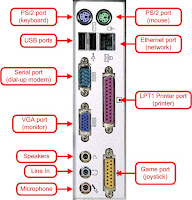PORTS
A system board with its processor and memory unit can work only when linked to input/output storage and communication devices to receive data and communicate results of processing. Peripheral devices such as a keyboard, mouse, monitor and a printer come with a cable and a multiple connector. To link a device to the PC, you plug its connector into a receptacle called a port in much the same way you plug a lamp cord into an electrical outlet. A port is one of the entry lines coming into the computer. A port provides a direct link to the microcomputer's common electrical bus. Most computer have several types of ports, each with different capabilities and uses. External peripheral devices outside the processor unit can be linked to the processor via cable through either a serial port or a parallel port. The system board is normally designed with at least one of each plus a dedicated keyboard port. Some have a dedicated port for the mouse. When a port is not available, you will need to install a circuit board that includes the port you need.
SERIAL PORTS
A serical port provides a connection for transmitting data one bit at a time. A serial port connects your computer to a device such as a modem, which requires two way data transmission, or to a device such as a mouse, which requires only one way data transmission, or to a device such as a mouse, which requires only one way data transmission. To connect a peripheral device to your computer through a serial port, both the device and your computer must have a serial port.
MOUSE PORTS
A mouse port is a special serial port that connects a mouse to a computer. The mouse port can be built into the main board or mounted on an expansion card. Many computers include a mouse port in addition to standard serial ports.
INPUT/OUTPUT DEVICES
To communicate with a computer, there must be convenient ways of transferring the data and instructions into the computer and getting the results out in an acceptable form. This is accomplished by the input/output devices or I/O devices. Input devices receive information from the outside, convert it from a form that is easily understandable by the user into a form that is acceptable for the computer. Output devices retrieve information from the computer memory. These input/output devices are similar to our senses, our limbs and our ability to speak to our brain.

No comments:
Post a Comment